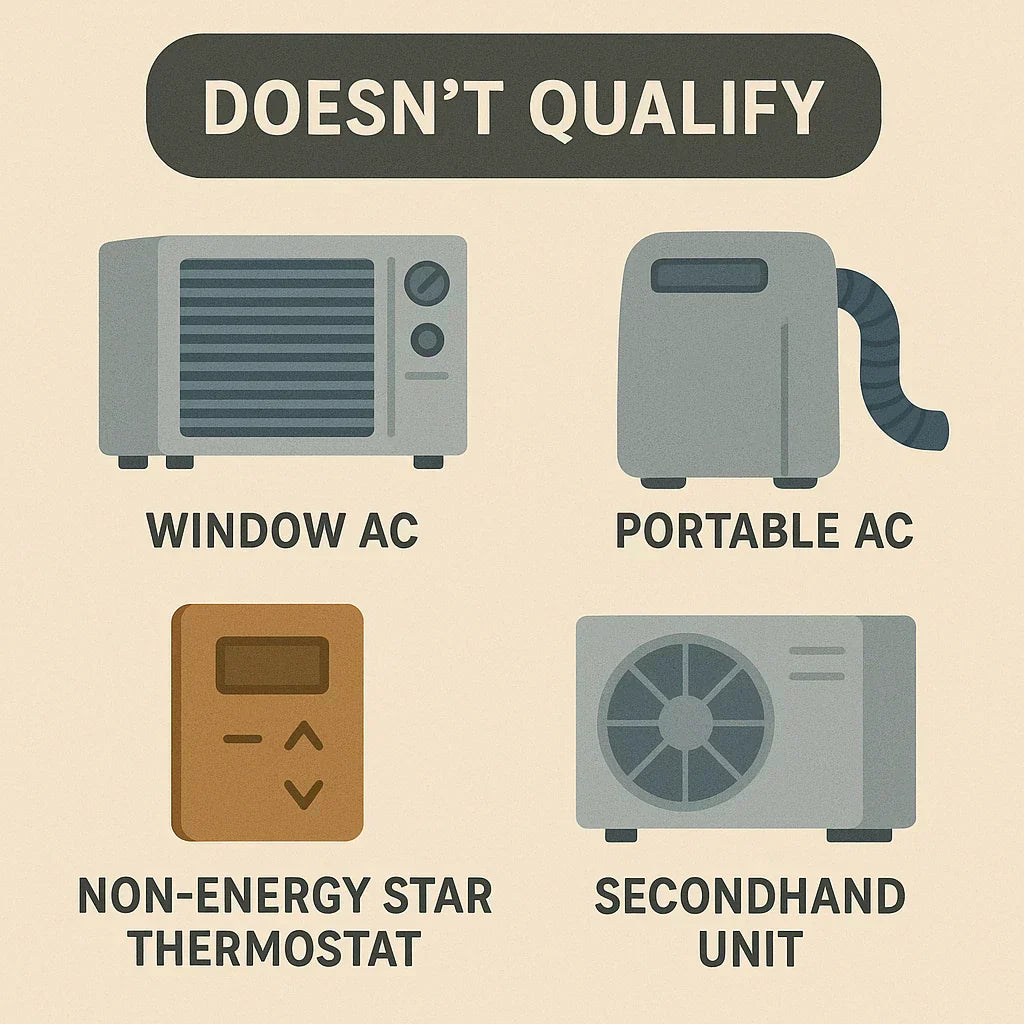When homeowners hear about tax credits for energy-efficient HVAC upgrades, it’s easy to assume every new purchase qualifies. Unfortunately, that’s not the case. In 2025, certain types of equipment simply don’t make the cut for federal tax credits under the Energy Efficient Home Improvement Credit (25C).
The good news? Knowing what doesn’t qualify can save you from disappointment and help you plan upgrades that maximize your savings.
📘 Start with the bigger picture here: 2025 HVAC Tax Credits & Rebates Explained.
Understanding 2025 Federal HVAC Tax Credit Rules
The federal government uses tax credits to encourage homeowners to invest in equipment that delivers long-term energy savings. The Energy Efficient Home Improvement Credit, renewed and expanded under the Inflation Reduction Act, offers up to:
-
$2,000 for qualifying heat pumps.
-
$600 each for high-efficiency central air conditioners, furnaces, and water heaters.
-
$1,200 annually for insulation, air sealing, and windows.
But not every HVAC product qualifies. The IRS and ENERGY STAR® set strict efficiency and certification requirements. If your system doesn’t meet those standards, you won’t get the credit — even if it’s brand new.
👉 For official details, see the IRS guidance on Energy Efficient Home Improvement Credits and the ENERGY STAR Federal Tax Credits page.
Common HVAC Equipment That Doesn’t Qualify
Here’s a breakdown of the most common HVAC equipment excluded from federal tax credits in 2025:
Window AC Units
While ENERGY STAR window ACs can reduce energy use compared to older models, they don’t qualify for federal tax credits. These units are considered supplemental rather than whole-home solutions. However, some local utilities offer rebates.
Portable AC Units
Portable ACs are even less efficient than window models. Because they provide temporary or localized cooling, they are not eligible for tax credits under current rules.
Non-ENERGY STAR Smart Thermostats
Smart thermostats are fantastic tools for reducing energy bills, but as of 2025, they are not covered by federal tax credits. That said, many utility programs offer rebates, sometimes even providing devices at steep discounts or for free. You can check the ENERGY STAR Smart Thermostat Rebate Finder for offers in your area.
Used or Secondhand Equipment
Tax credits apply only to new, certified systems. If you buy a used furnace or AC — even if it’s ENERGY STAR certified — you won’t qualify.
Non-Certified Furnaces or AC Units
Federal credits require that your system meets minimum efficiency thresholds, typically verified by AHRI (Air-Conditioning, Heating, and Refrigeration Institute) certification. If your installer can’t provide an AHRI certificate, you’re likely not eligible.
Why Some Equipment Gets Left Out
The federal government prioritizes high-impact energy savings. Whole-home systems like heat pumps, central ACs, and furnaces have the potential to reduce nationwide energy consumption significantly.
Portable and supplemental equipment, on the other hand, doesn’t deliver the same long-term efficiency. By excluding these products, the tax credit program channels funding where it makes the biggest difference.
For context, the U.S. Department of Energy’s Energy Saver guide highlights that whole-home HVAC systems account for nearly 50% of residential energy use — making them the biggest opportunity for savings.
Rebates You Can Still Claim for Non-Qualifying Equipment
Even if your equipment doesn’t qualify for federal tax credits, you may still have options:
-
Smart Thermostats – Many utilities offer $25–$100 rebates for ENERGY STAR-certified models.
-
Window AC Units – Some state programs, particularly in the Northeast, provide rebates when replacing older units with ENERGY STAR models.
-
Ductless Mini-Splits (if under minimum SEER2) – While not tax credit eligible, local rebate programs may still provide incentives.
To explore these options, check the Database of State Incentives for Renewables & Efficiency (DSIRE) and the ENERGY STAR rebate finder.
📘 Related reading: Are HVAC Tax Credits Retroactive? What If You Upgraded in Late 2024.
How to Confirm if Your Equipment Qualifies
Before you buy, here’s a quick checklist to avoid surprises:
-
Check the ENERGY STAR Certified Products list – Only qualifying models are eligible.
-
Review IRS 25C guidelines – Make sure your planned upgrade falls under eligible categories.
-
Ask for AHRI certification – Your installer should provide this for furnaces, ACs, and heat pumps.
-
Confirm state/utility programs – Rebates vary widely depending on your location.
If in doubt, confirm eligibility before purchase. Don’t assume the rebate or credit will apply.
The Bottom Line
In 2025, not all HVAC equipment qualifies for federal tax credits. Window and portable AC units, non-certified thermostats, secondhand systems, and non-ENERGY STAR products are generally excluded.
That doesn’t mean they’re worthless investments — many still qualify for utility or state rebates, and all can contribute to better comfort and lower bills. But if your goal is to maximize tax credits, focus on whole-home, high-efficiency systems.
The key takeaway? Always double-check the fine print before buying. With the right planning, you can avoid surprises and get the most from your investment.
Alex Lane
Your Home Comfort Advocate







